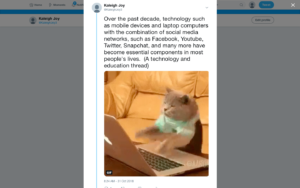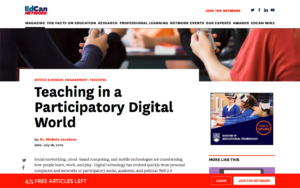For my second multimedia reflection I chose to reflect on “Teaching in a Participatory World” by Michele Jacobsen and the video “Henry Jenkins: The influence of participatory culture on education” with Henry Jenkins sharing his ideas. I did this in the form of a Twitter essay. Please visit my multimedia reflection Twitter essay on my public account @KaleighJoy3. I hope you like it, and maybe you can follow me since I have no followers. LOL

The essay starts with the frantic kitty and is easier to read when viewed on Twitter and by selecting “Show this thread” under any of the Tweets.
After reading the Jacobsen article and watching the Jenkins video, I absolutely agree that teachers in this day and age should be integrating social media and technology into their classrooms and embrace the meaningful contributions that these new age platforms make for learning opportunities. As Jenkins mentioned, teachers these days tend to shy away from social media, because they are afraid of the potential misuses students might engage in or inappropriate content they may view online when using their devices. However, I absolutely agree with Jenkins’ point that, because these students will be using social media on their own anyways, it is quite foolish that teachers would let them learn about the proper applications on their own. Because, if students are obsessed with their own social media accounts, as many teachers and I have observed, what makes people think that they will ever know how to properly use social media and technology in a positive, meaningful way, if they are never shown how by someone who is experienced in the field of educational social media applications? For example, if teachers notice that their students are obsessed with Snapchat, and in response, they ban using Snapchat from the classroom, this pushes students further away from what they will encounter in the future. By banning Snapchat or any social media site, the teacher is missing a great learning opportunity for where they could explain that although Snapchat and other sites are great, there is a time and a place. So, depending on the students’ response, the teacher could potentially allow them to use Snapchat while they are working if the students feel the great desire to do that. And yes, many students could be distracted by their apps and sites, but I think that is another opportunity for the teacher to demonstrate that at a high school level, maybe just grades elevens and twelves, if the students want to be distracted by their phones, that that is their choice and their grades will be reflected accordingly. If all they do is play on their devices, while given time to work and ask questions, then they are missing out significantly. It also serves to remind students that in post-secondary education or during their careers (depending on the career), they can spend tons of time updating their statuses and scrolling through pictures, but when their grades start dropping, or their boss is asking where their work is when its the deadline, it was their conscious decision to choose social media over their commitments and priorities.
In addition to knowing the right time and place, teachers could choose to use the same or similar social media applications to the ones their students like to use, and in a controlled learning environment, that can be a way of having students contribute their ideas and opinions in a platform that they enjoy using in their everyday life. To stick with the Snapchat example and a science class as the content area , perhaps the teacher could have each student pose a question on their story (these accounts would be school, classroom accounts only and not the students’ personal accounts), and then each student has to answer ten different classmates’ questions. In order to ensure that students are responding the teacher could ask students to keep a log of who they answered and what their answer was, and then if the teacher is really Snapchat savvy, they could go on each of the students’ account and ensure that their snap scores are increasing accordingly. This idea would have the potential to be misused by the students, so the teacher would have to determine if their class would benefit from this type of activity. If they believe their class is responsible enough to participate in this, then I believe it would be a great way for students to use something they use everyday for fun in a meaningful, learning context. There are so many platforms that could work and better engage students in digital participatory learning, and some will suit certain classes over others.
I found this to be a very enjoyable creation process, even being somebody who never uses Twitter. It made me feel quite creative the way I took my points and had to strategically arrange them so that they were short enough to not exceed the character count- short and tweet (see what I did there, ahhh lol). I also had a lot of fun selecting the GIFs, as I just find them very funny. Overall, I would recommend writing a Twitter essay to anybody who wants to try something new, and essentially write an essay in a very popular social media platform.
The idea of participatory learning was quite new to me before these past two weeks and I don’t have any true participatory experience that I can think of before taking this course. I have had to complete the odd discussion here and there in some of the online classes I have taken before. But, all of those discussions pretty much involved someone posting their opinion, and then somebody would comment that they agree, just to say that they did it and get the marks for it. Just last week, however, while tweeting in Twitter chat #unboundeq, I found that to be a collaborative educational experience, where me and a few other students in this class built on ideas from what each other was saying. I found that people’s additions to my ideas were very useful and allowed me to consider others’ perspectives. The #unboundeq made me very interested in participatory learning, and that is why I ultimately chose to watch the Jenkins video and read the Jacobsen article.
Be sure to read the article and watch the video if you haven’t had the chance, as both Jacobsen and Jenkins bring up great points with respect to what participatory culture is, and why teachers should integrate it into their classroom.
https://www.edcan.ca/articles/teaching-in-a-participatory-digital-world/

#UWINDIG
